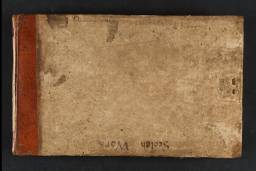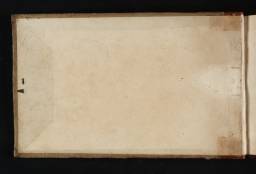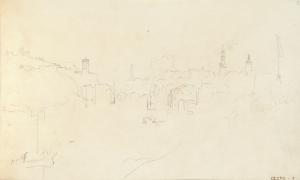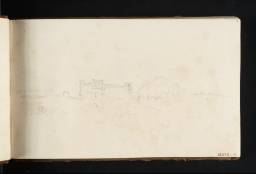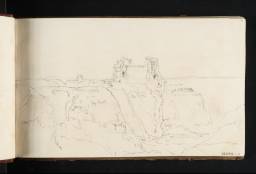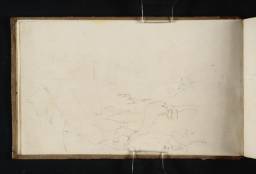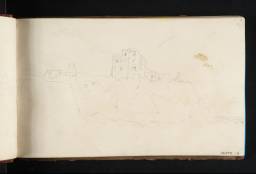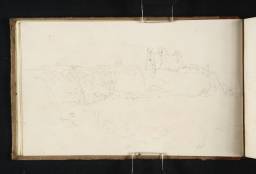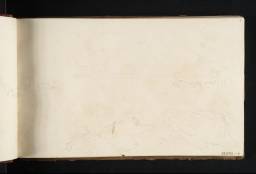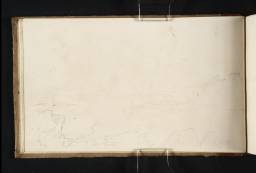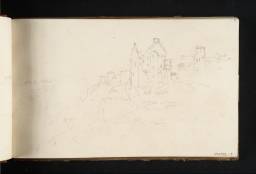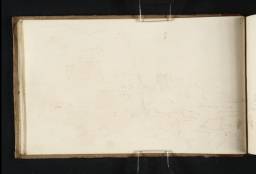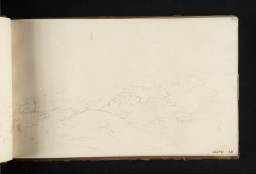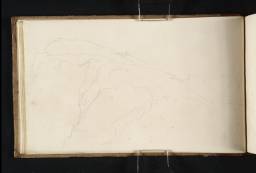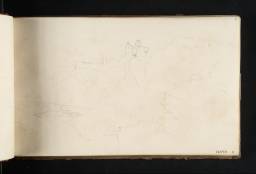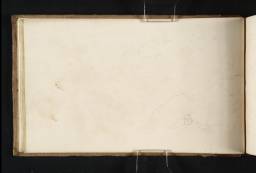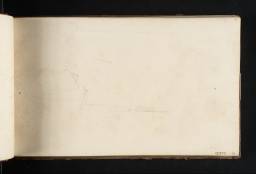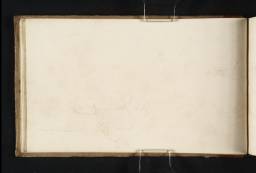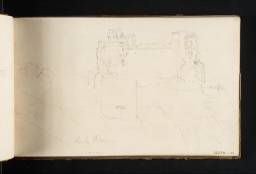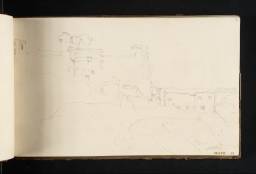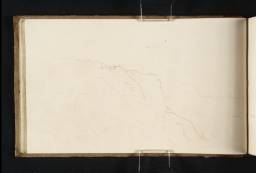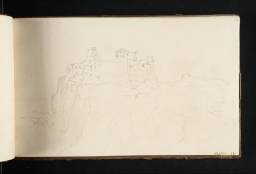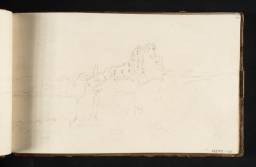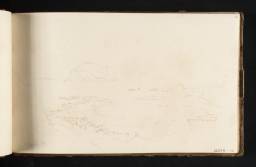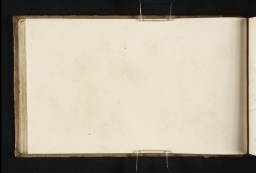Turner Bequest CLXVII
Quarterbound sketchbook, bound in cardboard, with brown leather back, and one broken brass clasp.
Paper label on spine inscribed in brown ink by Turner ‘89 Scotch Antiquits’
Ninety leaves of white wove paper, made by William Allee at Hurstbourne Prior Mill, Hampshire, and watermarked ‘ALLEE | 1813’ on folios 1, 3, 4, 7, 8, 11, 12, 14, 15, 18, 20, 23, 25, 26, 29, 30, 33, 37, 40, 41, 43, 44, 45, 47, 48, 51, 54, 55, 59, 62, 64, 65, 67, 68, 69, 76, 78, 79, 83, 84, 87, 88, 75 (see concordance below for Tate accession and Turner Bequest numbers).
Approximate page size 112 x 186 mm
Paper label on spine inscribed in brown ink by Turner ‘89 Scotch Antiquits’
Ninety leaves of white wove paper, made by William Allee at Hurstbourne Prior Mill, Hampshire, and watermarked ‘ALLEE | 1813’ on folios 1, 3, 4, 7, 8, 11, 12, 14, 15, 18, 20, 23, 25, 26, 29, 30, 33, 37, 40, 41, 43, 44, 45, 47, 48, 51, 54, 55, 59, 62, 64, 65, 67, 68, 69, 76, 78, 79, 83, 84, 87, 88, 75 (see concordance below for Tate accession and Turner Bequest numbers).
Approximate page size 112 x 186 mm
Exhibition history
References
The largest of the three sketchbooks that he took to Scotland in 1818, Turner used the ‘Scotch Antiquities’ sketchbook to make his most detailed and careful studies of the subjects that he was to illustrate for the Provincial Antiquities publication (see Tour of Scotland 1818 Tour Introduction). While the Bass Rock and Edinburgh (Tate D13322–D13448; D40682–D40684 complete group; Turner Bequest CLXV) and Edinburgh (1818) (Tate D13449–D13586; D40934–D40937; complete group; Turner Bequest CLXVI) sketchbooks were used to make numerous rapid visual notes as he travelled to and around his subjects, building up through multiple views a three-dimensional topographical picture of the places he visited, the Scotch Antiquities sketchbook was generally employed more systematically to record a subject from all directions in sequence (Linlithgow Palace, Dunbar, Tantallon Castle, Roslin Castle), and to make designs as the basis of later watercolour paintings.
In the case of Edinburgh High Street, Linlithgow, Dunbar, Tantallon, Roslin, Borthwick and Crichton Castles, Turner made a series of views, giving himself a choice of compositions when he planned his final watercolour. In many cases the sequence of sketches demonstrates the development of the artist’s understanding and ideas about a subject, with the latter drawings being the most highly developed, and often those used as the basis of the finished design. For example, the two sketches (folios 30 verso–31 and 33 verso–34; D13633–D13634 and D13639–D13640; CLXVII 29a–30 and 31c–32) that were used as the basis for Dunbar, circa 1823 (watercolour, private collection)1 along with a sketch in the Edinburgh, 1818 sketchbook (Tate D13496–D13497; Turner Bequest CLXVI 24a–25), come towards the end of a long sequence of fifteen sketches that show the artist moving around the ruins from west to east.
In other cases, however, it appears that Turner did not settle on his final composition while he was standing in front of the subject. There are, for example, twenty-one sketches of Linlithgow Palace and Church in this sketchbook (folio 43 verso–58; D13656–D13682; CLXVII 41a–55), as well as several in the Edinburgh, 1818 sketchbook, many of which were worked up to a relatively high level of finish, and were therefore sufficient to form the basis of a watercolour composition. Furthermore, Katrina Thomson has shown that Turner began an alternative sketch of Linlithgow Palace with a watercolour study (Tate D25325; Turner Bequest CCLXIII 203) based on an alternative sketch (folios 45 verso–46; D13660–D13661; CLXVII 43a–44) to those finally employed,2 indicating that he did not settle on his design for the Provincial Antiquities until very late in the process.
There are also two studies in this sketchbook that are almost unique sketches of a subject and show Turner confidently selected his view without the need to test a number of options. A detailed and beautifully executed drawing of Edinburgh from Calton Hill over three sketchbook pages (folios 41 verso–42 and 43; D13651–D13652 and D13654; CLXVII 39a–40 and 41) became, with very minor alterations, the foundation of the watercolour of the same name, Edinburgh from Calton Hill, circa 1819, (National Gallery of Scotland).3 Similarly a sketch of Heriot’s Hospital from the West Bow (folio 75; D13744; CLXVII 86) forms the basis of Turner’s watercolour, Heriot’s Hospital, circa 1819 (National Gallery of Scotland),4 and is just one of two depictions of the school; the other, in the Bass Rock and Edinburgh sketchbook (Tate D13447–D13446; Turner Bequest CLXV 68–67a), showing it from close up and providing useful information on the architecture.
Finally, the Bass Rock, circa 1824 (watercolour, Lady Lever Art Gallery, Port Sunlight),5 though sketched repeatedly in this and the Bass Rock and Edinburgh sketchbook, was based more directly on sketches made on his next visit to Scotland in 1822; although no single drawing from life formed the basis of the design which was a composite of many views from 1818 and 1822.
Two subjects depicted in the sketchbook were illustrated for the Provincial Antiquities, though, not in the event, by Turner. Craigmillar Castle, of which Turner made three sketches (folios 73 verso, 74 verso and 76 verso–77; D13743, D13707 and D13709–D13710; CLXVII 85a, 67a and 68a–69), was engraved for the fourth number of the publication by William Woolnoth after Revd John Thomson of Duddington, and Dalkeith, again illustrated by Thomson, was engraved for the second number by Henry Le Keux.
Other sketches in the book are either closely related to Provincial Antiquities subjects – such as various distant views of Edinburgh (see folios 38 verso, 39, 59 verso–64, 66 verso–67, 69 verso–73; D13646, D13647, D13685–D13694, D13699, D13700; D13705, D13738–D13742, D13746, D13747; CLXVII 36a, 37, 56a–61 ,63a, 64, 66a, 83–85, 87, 87a) – or were quickly sketched while on trips to commissioned subjects (Firth of Forth, St Bernard’s Well, Pentland Hills, folios 89 verso–90, 38, and 90 verso-Inside Back Cover; D13735–D13736, D13645, and D13737–D40916; CLXVII 81a–82, 38, and 90 verso–‘inside of cover’). The only real exception is the very first sketch in the book which was the only drawing made before Turner reached Scotland and is the only picture entirely unrelated to the Provincial Antiquities scheme. This is a sketch of Newcastle looking west along the Tyne (folio 2; D13588; CLXVII 2), and it was very closely followed for a watercolour, Newcastle-on-Tyne, circa 1823 (Tate D18144; Turner Bequest CCVIII K),6 which formed the basis of Thomas Lupton’s engraving for the Rivers of England series in 1823 (Tate T04791).7
In contrast to the Bass Rock and Edinburgh and Edinburgh, 1818 sketchbooks, the drawings in the Scotch Antiquities sketchbook tend to be more carefully rendered and vary from faint, but careful outline studies, to highly detailed finished drawings. Even in the most worked up sketches, however, there is still an economy of means, with no attempt to take the picture beyond the status of preparatory study.
There are several illuminating inscription in the sketchbook. On the inside back cover, a list of place names and prices probably refer to the fares that Turner paid on his journey north (D40916). Also on the page are the dimensions of the Provincial Antiquities watercolours (61/2 by 91/2 inches). An inscription earlier in the sketchbook indicates that Turner originally had other dimensions in mind (6 by 7 3/4) (folio 73 verso; D13743; CLXVII 85a), and also provides proposed dimensions for ‘Rhine Work’.
Technical notes
How to cite
Thomas Ardill, ‘Scotch Antiquities sketchbook 1818’, sketchbook, April 2008, in David Blayney Brown (ed.), J.M.W. Turner: Sketchbooks, Drawings and Watercolours, Tate Research Publication, December 2012, https://www

